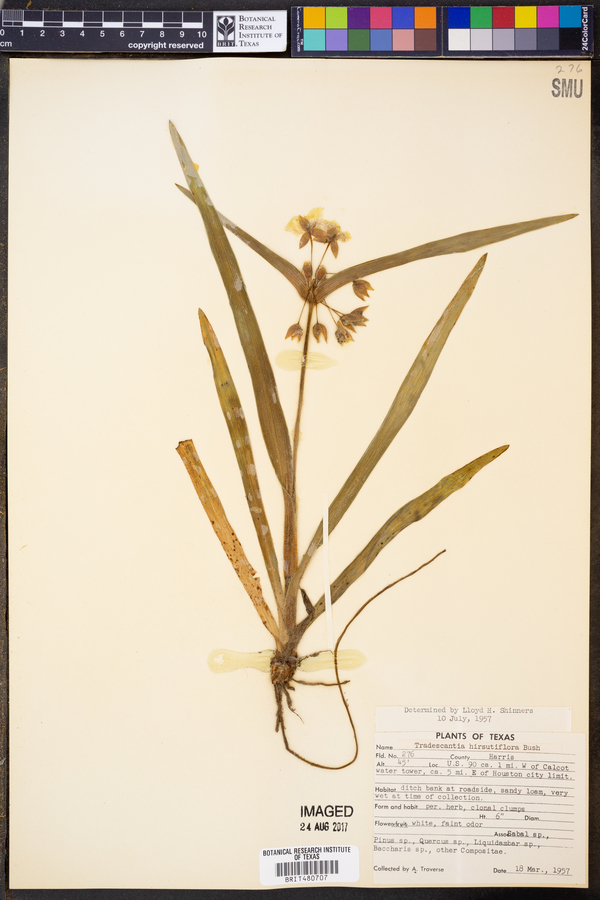Tradescantia
|
Family: Commelinaceae |
Herbs, perennial. Roots thin or tuberous. Leaves spirally arranged or 2-ranked; blade sessile or rarely petiolate [petiolate]. Inflorescences terminal or terminal and axillary, pairs of cymes, cymes sessile, umbel-like, contracted, subtended by spathaceous bract; bract similar to leaves or differentiated, margins distinct; bracteoles persistent. Flowers bisexual, radially symmetric; pedicels very short or well developed; sepals distinct (basally connate in T. zebrina), subequal; petals distinct (rarely connate basally), white to pink, blue, or violet, equal, rarely clawed; stamens 6, all fertile, equal; filaments bearded or glabrous; ovary 3-locular, ovules (1--)2 per locule, 1-seriate. Capsules 3-valved, 3-locular. Seeds 2 per locule (1 in T. spathacea); hilum oblong to linear; embryotega abaxial to lateral. x = 6--8, probably others. The species described by E. Anderson and R. E. Woodson Jr. (1935) are narrowly defined and typological. Nevertheless, they are recognizable entities even if some of them may prove eventually unworthy of specific rank. Where specific problems have been recognized, they are noted in the discussions at the end of the species. Tradescantia species hybridize freely when growing together (E. Anderson and R. E. Woodson Jr. 1935). My observations in the field and garden tend to confirm this. The definite or probable hybrids are listed after the species. The list is almost certainly incomplete. The questionable records are based on uncertain determinations. The record of a possible hybrid between T. ohiensis and Callisia rosea (as Cuthbertia rosea), cited by Anderson and Woodson, is omitted: the specimens appear to be merely gracile plants of T. ohiensis. Some native species are occasionally cultivated, although most garden plants seem to be hybrids of T. virginiana and other species (E. Anderson 1952). They are usually sold as Tradescantia ´ andersoniana (an invalid name) followed by a cultivar epithet.
PLANT: Perennial, glabrous to hispidulous, the roots fibrous or tuberous. STEMS: prostrate or erect, simple to branched. LEAVES: lanceolate to linear-lanceolate. INFLORESCENCE: terminal or terminal and axillary, composed of pairs of sessile cymes, each cyme subtended by a foliose bract. FLOWERS: perfect, actinomorphic; sepals free, subequal; petals distinct, equal, usually elliptic to ovate (rarely clawed); stamens equal, all fertile, the filaments bearded or sometimes glabrous; ovary 3-locular, the ovules (1-)2 per locule. FRUITS: 3-valved, 3-locular. SEEDS: with hilum oblong to linear. NOTES: ca. 70 spp.; neotemperate and neotropical (for John Tradescant). REFERENCES: Puente, Raul, and Robert B. Faden. 200. Commelinaceae. J. Ariz. - Nev. Acad. Sci. Volume 33(1). Sep 3, herbaceous, green or anthocyanic; pet 3, all alike, obovate to elliptic, blue or pink (white); stamens 6; filaments usually villous; ovary 3- locular, with 1-2 ovules per locule; style slender; stigma capitate; fr loculicidal; perennial herbs, usually somewhat succulent, with elongate, linear to lanceolate lvs dilated into conspicuous basal sheaths, the umbel-like cymes of several to many handsome fls subtended by elongate foliaceous bracts (except for the last sp.). Except for T. virginiana, our spp. bloom in summer and early fall. 50, New World. Gleason, Henry A. & Cronquist, Arthur J. 1991. Manual of vascular plants of northeastern United States and adjacent Canada. lxxv + 910 pp. ©The New York Botanical Garden. All rights reserved. Used by permission. |

